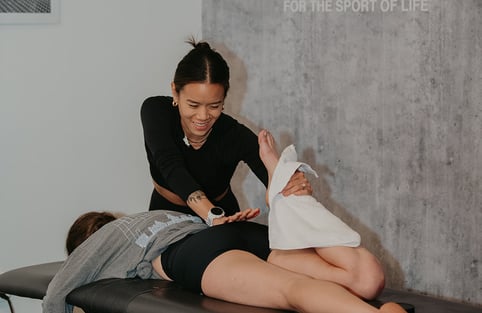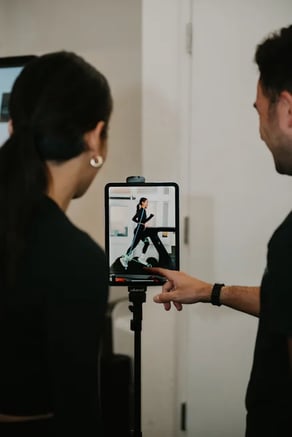Common Sports Injuries, And How Physical Therapy Can Help
February 9, 2024
Whether you're a seasoned athlete or a weekend warrior, sports injuries are an unfortunate but common occurrence in the world of physical activity. From minor strains to serious fractures, the realm of sports encompasses a wide range of potential risks to our bodies.
In today's digital world, it can be all too easy to turn to social media for quick fix exercises to solve our problems. But your body is unique to you, and the best solution is one that is specific to your strengths and weaknesses. Keep reading to learn about the most common sports injuries that we see as Physical Therapists, and what questions we ask to tailor our treatment plan to you and you alone.

1. Patellofemoral Knee Pain
What is it?
Knee pain commonly reported as around or under the kneecap, typically occursing during activities that involve knee flexion, such as running, squatting, or climbing stairs. PFPS is often referred to as "runner's knee" but can affect any athletes playing sports that require repetitive knee movements.
What do we want to know?
While patellofemoral pain symptoms are typically localized to the knee joint, the root cause can often be found elsewhere. Are your muscles able to control your knee position when you are moving? Do you have full ankle mobility or is your knee compensating for a lack of ankle movement? Are the structures around your knee, like ligaments or tendons, able to tolerate the amount of force your knee undergoes when playing your sport?
2. Muscle Strains
What is it?
Also known as a pulled muscle, strains involve tearing of muscle fibers. While this may sound scary, any given muscle has lots and lots of fibers, so by no means does a strain mean that you've torn your entire muscle.
What do we want to know?
The most common thinking behind muscle strains is that the muscle was too tight and "ripped." While this is certainly a line of thinking that should be evaluated, more often than not, a muscle strain occurs when a muscle is improperly prepared for the stress that it encounters in sport. Instead of assuming tightness, we want to compare the strength and power of your muscle in relation to the strength and power needed to perform in your sport.
3. Achilles Tendinopathy
What is it?
The Achilles is a tendon that attaches your calf muscles to your heel, and tendinopathy is a term for tendon dysfunction. The more common term you'll hear is tendinitis: an acute inflammation of the tendon that can lead to tendon degeneration and chronic pain if left untreated.
What do we want to know?
Tendon dysfunction in the Achilles or anywhere else in your body is usually caused by a tendon undergoing repetitive stress that it is not prepared for (sound familiar?). We want to dive into your training history with questions like: Did you jump into your sport too quickly, like playing a 2 hour pickup basketball game after 6 months off, or running 30 miles in a week after only running 10 the previous weeks?
For the Achilles in particular, even your footwear (do you wear a low drop shoe?) or running on inclines vs. declines can matter (incline running creates higher forces at the Achilles while decline running creates higher forces at the knee).
4. Shoulder Impingement
What is it?
Shoulder impingement is characterized by compression or pinching of the structures within the shoulder joint, particularly the tendons of the rotator cuff. Pain commonly occurs with overhead activities or reaching behind the back.
What do we want to know?
Impingement is often blamed on weak rotator cuff muscles. While that may be a contributing factor, we also want to explore the functionality of your scapulae (shoulder blades) and your thoracic spine. Scapular mobility contribute significantly to your ability to raise your arm overhead, so discovering if your scapula can rotate, tilt, and protract/retract properly is essential to understanding your shoulder's overall function.
This is true with your thoracic spine as well. Imagine the Hunchback of Notre Dame; do you think he would be able to raise his arm to a full 180 degrees of flexion? Similarly, your ability to flex and extend your spine are crucial to your ability to get into an overhead squat or to serve a tennis ball.
5. Low Back Pain
What is it?
The plague of all plagues in today's society, low back pain can be caused from a litany of spinal degenerative disorders, but can just as commonly be caused by muscular imbalances or postural weaknesses.
What do we want to know?
Social media is awash with core exercises to target your back pain. But how you think about your core matters. For example, your diaphragm is an integral part to your core, so we must understand how you breathe or how you create internal pressure when moving.
We often worry about our posture in photos, but consider how your posture changes when you are playing sports. Without the ability to breathe and maintain tension within movement, you'll not only lose power in your kicks, throws, or hits, but your back will also be at the mercy of the forces acting upon it.
Then there are the surrounding structures that affect your back: are your hips so locked up that your low back has to compensate? What about your neck and upper back? They are connected to your lower back after all.
*To note: low back pain can also stem from many different internal issues such as kidney infection or spinal cancer, so it is important that your physical therapist asks questions about medical conditions if you haven't seen a doctor first.

If there is one thing to take away from this journal entry, it is that rehabbing injuries is nuanced and a detailed assessment of your body is crucial to a specific and efficient plan of care. For more on Physical Therapy and it's benefits, check out this journal entry on Finding the Right Physical Therapist for YOUR Needs. If you're ready to do a deep dive into your body, tap the link below to meet with a PT today.

Jessica Hartnett
Doctor of Physical Therapist and self-proclaimed adrenaline junkie.
jess@motivny.com